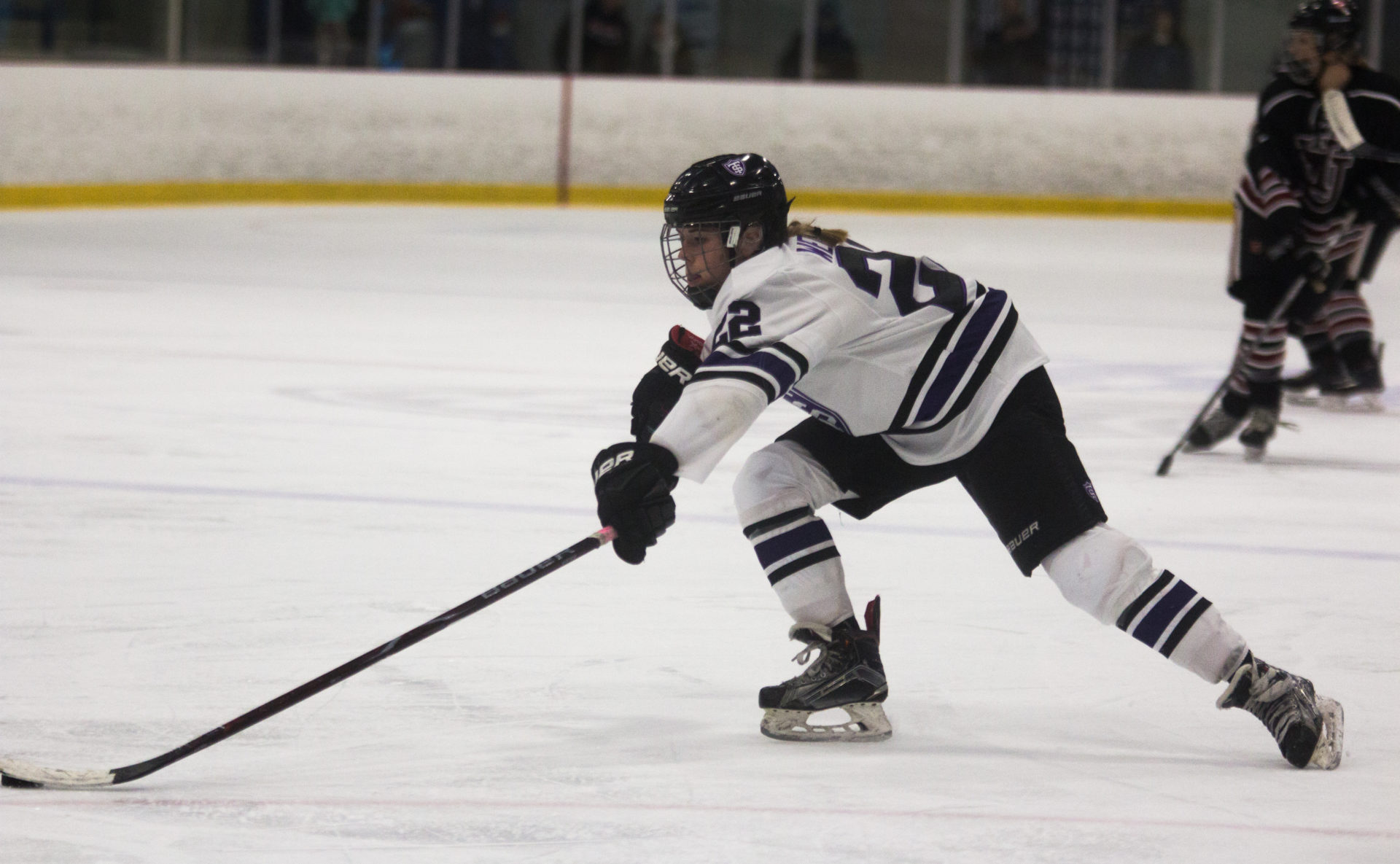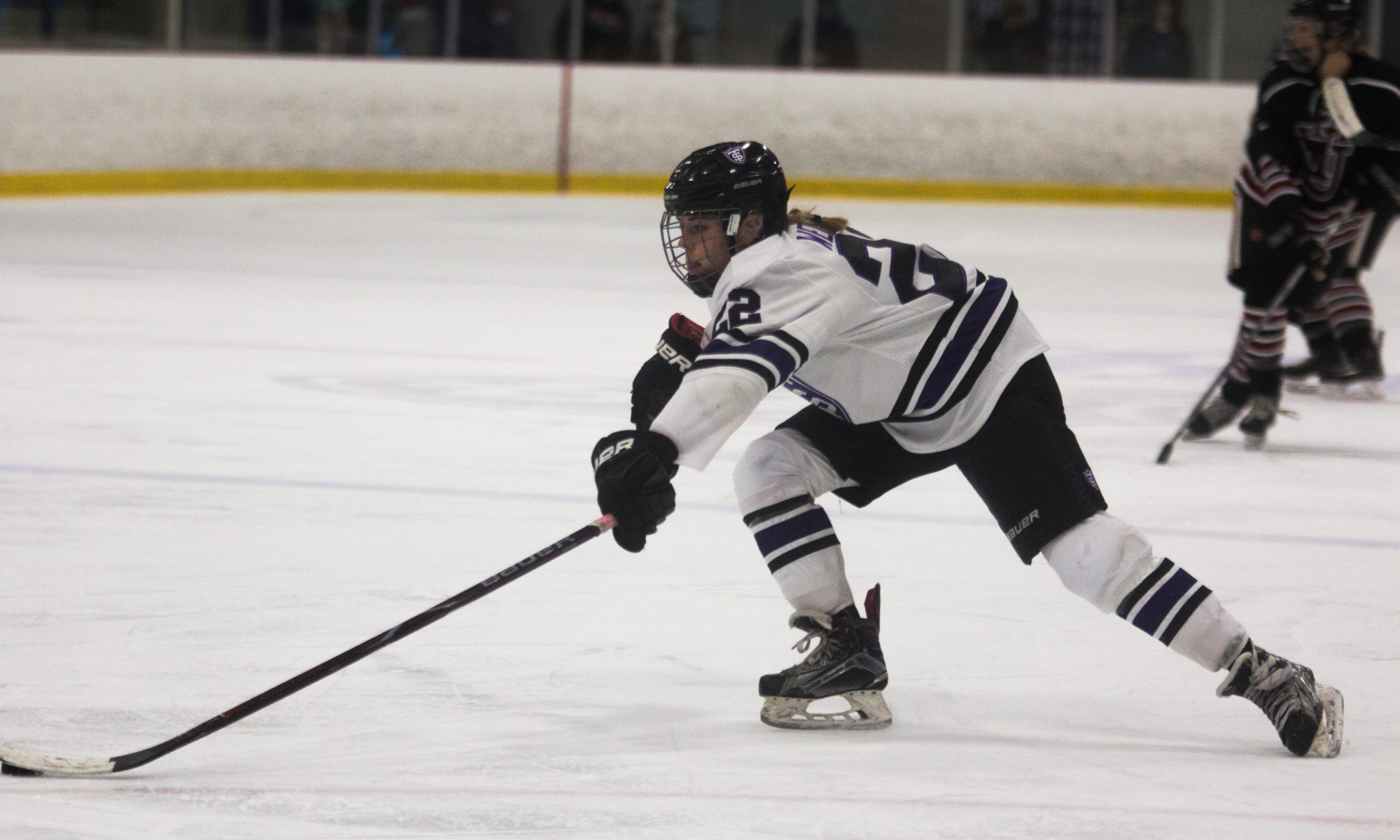
A Tommie hockey player skates across the ice. Commissioners of the Western Collegiate Hockey Associations are interested in St. Thomas, but caution much work remains before that can happen. (TommieMedia file photo)
The commissioners of the men’s and women’s Western Collegiate Hockey Associations are interested in adding St. Thomas to their leagues, but they caution that much work remains before that can happen.
Both commissioners characterized their conversations with the university as informal.
Timing, investment of resources and the need for unprecedented approval from the NCAA are all issues that must be addressed before St. Thomas could become part of one or both leagues.
The university is looking for a new conference to call home after its involuntary removal from the MIAC last spring. The Division I Summit League has invited St. Thomas to join, although the NCAA must grant a first-of-its-kind waiver for the university to jump straight from Division III to D-I.
Because the Summit League does not include football, men’s hockey or women’s hockey, those sports would need to find other conferences in order to compete. The Western Collegiate Hockey Association could be that home for Tommies men’s and women’s hockey.
“I’m a proponent of more schools playing Division I hockey, and I grew up in St. Paul. I think it would be a wonderful situation for the University of St. Thomas to play Division I hockey, and I would love to see them eventually play in the WCHA,” said WCHA Men’s Commissioner Bill Robertson in an interview with TommieMedia.
For the men’s division, the WCHA is facing an exodus of seven of its current 10 men’s teams. The group of seven include Bemidji State, Bowling Green State, Ferris State, Lake Superior State, Michigan Tech, Minnesota State and Northern Michigan. They will try to construct their own conference that will start play in the 2021-2022 season.
In response to this, Robertson said, “I would say from our perspective we’re certainly going to move forward and do the best we can to add additional programs to the WCHA, whether they’re some of the original seven that are leaving, or there are others that are out there… We have a plan and a vision in place to grow the WCHA, and we’re working on that currently.”
On the flip side, the WCHA’s women’s division is solid with seven teams, including Bemidji State, Minnesota, Minnesota Duluth, Minnesota State, Ohio State, St. Cloud State and Wisconsin.
WCHA Women’s Commissioner Jennifer Flowers said, “It’s no secret that our league wants to be at eight, and having a regionally based institution as an option is obviously a huge advantage for us. So there’s certainly interest I think on both sides.”
St. Thomas would have to go through a formal application process before joining the conference, but the university would bring a “very solid Division III program” to the conference, according to Flowers.
However, Flowers said, “It’s interesting to have this idea that we may have six Minnesota teams in our league. That’s a lot, and even though Minnesota is the state of hockey, and obviously the leader in girls hockey participation in the country, it’s a lot to have six institutions in one space.”
If St. Thomas joined the conference, its lineup would include six Minnesota schools and then Ohio State and Wisconsin, so while having another regional school brings positives, it pulls the conference even further into Minnesota. The conference is the best D-I competitive hockey conference in the country, winning 17 national championships since the conference’s inception in 1999, so St. Thomas would have to adjust to this increased competition.
“I think that transition could be difficult. It might not be, it might prove to be much more seamless than we anticipate,” Flowers said. “I have no doubt that if the decision is made to go Division I, and they’re jumping into the WCHA, that St. Thomas is going to do everything that they need to do to be as competitive as they can be.”
If St. Thomas gains the NCAA’s approval to jump to D-I play, the university will most likely be required to make changes to both the men’s and women’s hockey programs.
“It’s an investment in a program, and not just financially,” Robertson said. “It’s with coaching, recruiting, spending money on those areas. You know, you have to have dedicated people as far as equipment managers and trainers to that specific sport, and they need to be there year round to help student athletes.”
Facilities also come into play. Both men’s and women’s hockey currently play at the St. Thomas Ice Arena, which is also home to the St. Thomas Academy Cadets. The facility holds up to 1,400 spectators and is about 20 minutes from campus.
WCHA men’s hockey facilities range between 2,500 and 8,000, but the ideal is between 4,000 and 5,000, according to Robertson. He said, “(St. Thomas) would need a new facility, or they would have to build upon the St. Thomas Academy site.”
However, in regard to how the St. Thomas Ice Arena compares to the other women’s facilities, Flowers said, “Most importantly, I think our league, as you go through the application process, would have a chance to answer questions, tour the facility, really get a feel for what it may or may not look like, but I don’t believe the current facility poses any immediate problems.”
On the men’s side, Robertson said the Tommies can succeed playing at the D-I level, but “it’ll take a huge effort, and you’re going to have to have the backing, not only of the administration at St. Thomas, but also from some donors and people that want to see it succeed.”
In a statement to TommieMedia, the St. Thomas Athletic Department said the university “has engaged in conversations” with several potential conferences, including the WCHA. Once the NCAA acts on the school’s request to reclassify to Division I, the department said, “We’ll be in a position to have more active discussions about a future home for our hockey teams.”
Flowers compared St. Thomas to schools like Butler, Marquette and Drake as having the same institutional makeup.
“If there’s an institution who has the capability to make the jump, has conferences who are willing to accept them and shows the financials and necessary tools to make the jump, I think they should be able to make the jump,” Flowers said. “But my guess is we’re looking at somewhere between three to six more months before we have a final answer.”
Maddie Peters can be reached at pete9542@stthomas.edu.
Carly Noble, Justin Amaker and Jacob Schneider contributed to this report.



